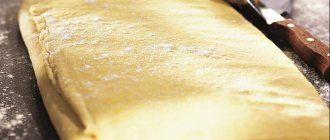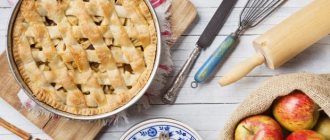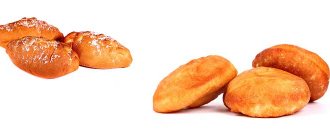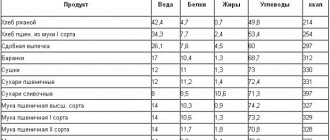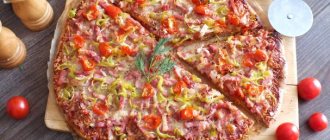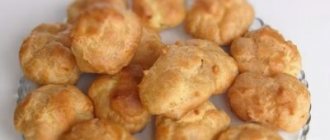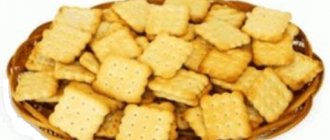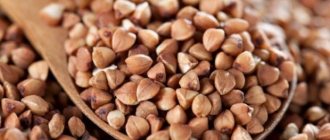Properties of yeast-free dough
Nutritional value and composition | Vitamins | Minerals
How much does yeast-free dough cost (average price per 1 kg)?
Moscow and Moscow region.
100 rub.
It is quite clear that almost any baked goods are nothing more than a culinary product that is made from various types of dough. That is why it contains a considerable amount of carbohydrates, proteins, vitamins, minerals and fats. All these elements, brought together, give the body the necessary boost of energy that it needs throughout the day.
Due to their high nutritional value, flour products are quite high in calories, which is important for people with insufficient body weight, but for those prone to obesity, the issue of consuming such products is quite acute. But be that as it may, extra pounds can only appear if you consume excessive amounts of baked goods. In addition, in order to be sure exactly how such a delicacy will affect your appearance, you need to know what type of dough the baked goods are made from.
Honey charlotte with rye flour
Thanks to the rich content of dietary fiber, microelements, vitamins and fiber, rye baked goods are surprisingly healthy. Rye dough rises easily and quickly, even without yeast. And dietary baking with apples on rye flour is also extremely tasty and aromatic.
| [:product:cher0010:] | [:product:ariv0005:] | [:product:elfa0164:] |
So take:
- 150g rye flour,
- 150 g oatmeal,
- 2 chicken eggs,
- 1 glass of kefir,
- 3 tsp honey,
- 1 tsp baking powder,
- 2 medium apples.
Preparation:
- Grind oatmeal or cereal in a blender cup.
- Mix with flour, gradually adding honey, kefir and separately beaten eggs.
- Let it sit for a bit so that the oatmeal swells, then add the baking powder.
- Cut the apples into small pieces and place them evenly in the mold, carefully pour the resulting dough. Charlotte is baked at 180 degrees for about 30 minutes.
Types of yeast-free dough
So, absolutely all types of dough are divided into 2 groups: yeast-free dough and yeast dough. There are, in turn, quite a lot of types of yeast-free dough: biscuit, unleavened butter, choux, shortbread, puff pastry and some others. It is known that all culinary products made from dough must have a porous structure so that hot air can easily penetrate into the product during the baking process. So, to create this porosity, special substances are used, which are called disintegrants. From the name it is clear that for yeast dough it is yeast.
As for yeast-free dough, there are 2 types of leavening methods: chemical and mechanical. The first includes ammonium carbonate and drinking water. When the product is baked, these elements begin to decompose and release carbon dioxide, which gives the finished dish a porous structure.
And mechanical methods for loosening some types of yeast-free dough include rolling (in the case of puff pastry) or beating (this applies to biscuits). In addition, some substances contained in milk and eggs have the same effect on the dough as mechanical leavening techniques - they give it porosity.
It is worth noting that the general rule for all types of yeast-free dough is to use eggs and wheat flour without adding yeast. For example, to make a sponge cake you need eggs, flour and sugar, but to make shortcrust pastry you will also need butter, which is often replaced with margarine. When it comes to puff pastry, egg whites are often used instead of eggs.
A rather interesting version of yeast-free dough is choux pastry, which necessarily includes a very large number of eggs, flour and butter. It is so called in connection with the method of preparation, which is characterized by brewing these products in boiling water.
In cooking and confectionery, in particular, a large number of different dishes are prepared from yeast-free dough. These can be buns and cakes, pies with or without filling, croutons and puff pastries, as well as pastries that are decorated with berries, fruits or all kinds of creams. However, with such a variety of delicious culinary creations, one should not forget that the calorie content of yeast-free dough is quite high, so you should not get carried away with it, adhering to the rule of the golden mean.
Ginger cookies with wholemeal flour
Wholemeal flour or flour with bran is considered more healthy due to its increased content of fiber, vitamins and microelements.
You will need:
- 10 tbsp. – flour with bran,
- 1 chicken egg,
- 1 tbsp. – cane sugar,
- 100g – butter,
- 2 tsp - ground ginger,
- 1 tsp – cinnamon,
- 3 tsp – honey,
- 1 baking powder.
| [:product:nata0013:] | [:product:elfa0162:] | [:product:alne0011:] |
Preparation:
- Grind butter and sugar in a bowl, add beaten egg and honey.
- In a separate container, mix the remaining ingredients, add the butter mixture and knead the dough.
- Place the dough in the refrigerator for at least an hour. Preheat the oven to 180 degrees.
- Roll out the dough 0.5 cm thick and cut out cookies using cookie cutters.
- Line a baking sheet with a sheet of parchment and bake cookies for 7-10 minutes.
Recipe Dough raw. Calorie, chemical composition and nutritional value.
Nutritional value and chemical composition of “Raw dough”.
The table shows the nutritional content (calories, proteins, fats, carbohydrates, vitamins and minerals) per 100 grams of edible portion.
| Nutrient | Quantity | Norm** | % of the norm in 100 g | % of the norm in 100 kcal | 100% normal |
| Calorie content | 246.7 kcal | 1684 kcal | 14.6% | 5.9% | 683 g |
| Squirrels | 6.8 g | 76 g | 8.9% | 3.6% | 1118 g |
| Fats | 3.9 g | 56 g | 7% | 2.8% | 1436 g |
| Carbohydrates | 46.2 g | 219 g | 21.1% | 8.6% | 474 g |
| Alimentary fiber | 2.2 g | 20 g | 11% | 4.5% | 909 g |
| Water | 39.6 g | 2273 g | 1.7% | 0.7% | 5740 g |
| Ash | 1.219 g | ~ | |||
| Vitamins | |||||
| Vitamin B1, thiamine | 0.11 mg | 1.5 mg | 7.3% | 3% | 1364 g |
| Vitamin B2, riboflavin | 0.028 mg | 1.8 mg | 1.6% | 0.6% | 6429 g |
| Vitamin B4, choline | 32.71 mg | 500 mg | 6.5% | 2.6% | 1529 g |
| Vitamin B5, pantothenic | 0.207 mg | 5 mg | 4.1% | 1.7% | 2415 g |
| Vitamin B6, pyridoxine | 0.109 mg | 2 mg | 5.5% | 2.2% | 1835 |
| Vitamin B9, folates | 19.5 mcg | 400 mcg | 4.9% | 2% | 2051 g |
| Vitamin E, alpha tocopherol, TE | 1.315 mg | 15 mg | 8.8% | 3.6% | 1141 g |
| Vitamin H, biotin | 1.392 mcg | 50 mcg | 2.8% | 1.1% | 3592 g |
| Vitamin K, phylloquinone | 2 mcg | 120 mcg | 1.7% | 0.7% | 6000 g |
| Vitamin RR, NE | 1.9504 mg | 20 mg | 9.8% | 4% | 1025 g |
| Niacin | 0.806 mg | ~ | |||
| Macronutrients | |||||
| Potassium, K | 79.53 mg | 2500 mg | 3.2% | 1.3% | 3143 g |
| Calcium, Ca | 16.2 mg | 1000 mg | 1.6% | 0.6% | 6173 g |
| Silicon, Si | 2.515 mg | 30 mg | 8.4% | 3.4% | 1193 g |
| Magnesium, Mg | 10.79 mg | 400 mg | 2.7% | 1.1% | 3707 g |
| Sodium, Na | 348.58 mg | 1300 mg | 26.8% | 10.9% | 373 g |
| Sera, S | 45.93 mg | 1000 mg | 4.6% | 1.9% | 2177 g |
| Phosphorus, P | 56.6 mg | 800 mg | 7.1% | 2.9% | 1413 g |
| Chlorine, Cl | 546.93 mg | 2300 mg | 23.8% | 9.6% | 421 g |
| Microelements | |||||
| Aluminium, Al | 660.2 mcg | ~ | |||
| Bor, B | 23.3 mcg | ~ | |||
| Vanadium, V | 56.59 mcg | ~ | |||
| Iron, Fe | 0.814 mg | 18 mg | 4.5% | 1.8% | 2211 g |
| Yod, I | 0.96 mcg | 150 mcg | 0.6% | 0.2% | 15625 g |
| Cobalt, Co | 1.14 mcg | 10 mcg | 11.4% | 4.6% | 877 g |
| Manganese, Mn | 0.3804 mg | 2 mg | 19% | 7.7% | 526 g |
| Copper, Cu | 66.92 mcg | 1000 mcg | 6.7% | 2.7% | 1494 g |
| Molybdenum, Mo | 9.368 mcg | 70 mcg | 13.4% | 5.4% | 747 g |
| Nickel, Ni | 1.383 mcg | ~ | |||
| Tin, Sn | 3.27 mcg | ~ | |||
| Selenium, Se | 3.774 mcg | 55 mcg | 6.9% | 2.8% | 1457 g |
| Titanium, Ti | 6.92 mcg | ~ | |||
| Fluorine, F | 44.35 mcg | 4000 mcg | 1.1% | 0.4% | 9019 g |
| Chromium, Cr | 1.38 mcg | 50 mcg | 2.8% | 1.1% | 3623 g |
| Zinc, Zn | 0.451 mg | 12 mg | 3.8% | 1.5% | 2661 g |
| Digestible carbohydrates | |||||
| Starch and dextrins | 42.696 g | ~ | |||
| Mono- and disaccharides (sugars) | 2.9 g | max 100 g | |||
| Essential amino acids | |||||
| Arginine* | 0.002 g | ~ | |||
| Valin | 0.003 g | ~ | |||
| Histidine* | 0.001 g | ~ | |||
| Isoleucine | 0.003 g | ~ | |||
| Leucine | 0.004 g | ~ | |||
| Lysine | 0.004 g | ~ | |||
| Methionine | 0.001 g | ~ | |||
| Methionine + Cysteine | 0.002 g | ~ | |||
| Threonine | 0.003 g | ~ | |||
| Tryptophan | 0.001 g | ~ | |||
| Phenylalanine | 0.002 g | ~ | |||
| Phenylalanine+Tyrosine | 0.005 g | ~ | |||
| Nonessential amino acids | |||||
| Alanin | 0.002 g | ~ | |||
| Aspartic acid | 0.003 g | ~ | |||
| Glycine | 0.002 g | ~ | |||
| Glutamic acid | 0.007 g | ~ | |||
| Proline | 0.002 g | ~ | |||
| Serin | 0.003 g | ~ | |||
| Tyrosine | 0.003 g | ~ | |||
| Cysteine | 0.001 g | ~ | |||
| Sterols (sterols) | |||||
| Cholesterol | 1.16 mg | max 300 mg | |||
| beta sitosterol | 3.041 mg | ~ | |||
| Saturated fatty acids | |||||
| Saturated fatty acids | 0.6 g | max 18.7 g | |||
| 16:0 Palmitinaya | 0.394 g | ~ | |||
| 18:0 Stearic | 0.076 g | ~ | |||
| 20:0 Arakhinovaya | 0.026 g | ~ | |||
| Monounsaturated fatty acids | 2.039 g | min 16.8 g | 12.1% | 4.9% | |
| 16:1 Palmitoleic | 0.048 g | ~ | |||
| 18:1 Oleic (omega-9) | 1.977 g | ~ | |||
| 20:1 Gadoleic (omega-9) | 0.015 g | ~ | |||
| Polyunsaturated fatty acids | 0.403 g | from 11.2 to 20.6 g | 3.6% | 1.5% | |
| 18:2 Linolevaya | 0.366 g | ~ | |||
| Omega-6 fatty acids | 0.6 g | from 4.7 to 16.8 g | 12.8% | 5.2% |
The energy value of raw dough is 246.7 kcal.
Primary Source: Created in the application by the user. Read more.
** This table shows the average levels of vitamins and minerals for an adult. If you want to know the norms taking into account your gender, age and other factors, then use the “My Healthy Diet” application.
Yeast
It is the most harmful according to nutritionists. Because when yeast enters the body, it begins to negatively affect the beneficial intestinal microflora and immunity. Dry yeast, which we add to baked goods, is especially dangerous. Convenient and tasty, does not mean healthy at all!
A beautiful, rosy pie that gets into the stomach along with yeast can cause heaviness. Digesting flour products is already not an easy task, and in combination with yeast it can cause many health problems. Especially if we abuse yeast bread from the store, as in this video.
Kneading technology and forming blanks
To maximize the development of the gluten framework, the puff pastry is kneaded intensively. Basic kneading rules:
- the dough should be cold (to slow down the fermentation process), lamellar (for rolling), strong consistency (to eliminate the possibility of spreading during the defrosting process);
- develop gluten as much as possible, this will improve gas and dimensional stability;
- eliminate the possibility of yeast fermentation before freezing the product.
Puff pastry without yeast is prepared from the following ingredients: melange, citric acid solution, milk powder, cold water, flour, flour improver, liquid margarine or vegetable oil. The components are placed in the bowl of the dough mixing machine and the machine is started. The duration of the kneading varies from 10 to 20 minutes and depends on the technical characteristics of the device. The output should form a strong, homogeneous mass. The well-kneaded dough is left to rest in a cool place (room temperature should not exceed 18 degrees Celsius) for half an hour until the proteins swell.
The principle of preparing the yeast base is similar. The only difference is the introduction of “fermenting” fungi after loading all the ingredients. In this case, the yeast must first be diluted in cold water and distributed evenly throughout the dough mass.
After a good kneading, the workpiece is placed in the refrigerator to avoid premature awakening of yeast cells and the formation of a gluten frame.
The next stage is rolling out the dough on laminators until the layer thickness is 1-2 mm. Then it is folded and the layers are allowed to rest for 15-20 minutes. During this time, the workpiece cools and rests after intense mechanical action. The procedure is repeated.
The number of rolls depends on the required number of layers and is about one and a half hundred. After this, the dough is cut and then formed into pieces for freezing or baking. It is very important to ensure the sharpness of the cutting elements. Otherwise, when cutting dough with dull knives, the edges become jammed, which leads to sticking and damage to the appearance of the product during heat treatment.
Next, the semi-finished products are molded, frozen, and packaged in moisture- and air-tight, cold-resistant, sealed packages. The duration of storage of blanks depends on the correct adherence to the production cycle and the quality of raw materials.
The shelf life of frozen dough varies from 5 to 60 days at a temperature of 12-20 degrees below zero.
Thawed semi-finished puff pastry products must not be re-frozen.
